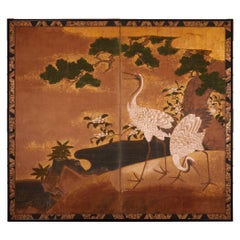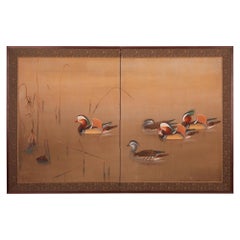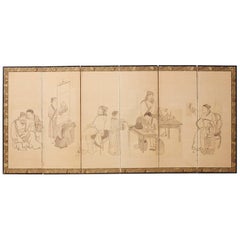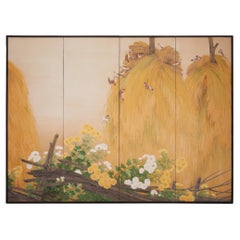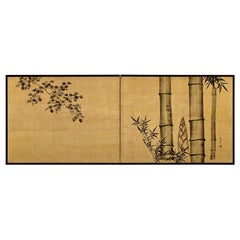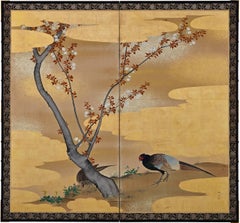Japanese Paintings
343
4
to
16
248
39
347
347
347
11
6
1
1
1
51
133
159
4
82
44
16
14
1
12
4
1
2
6
9
1
Height
to
Width
to
217
184
148
145
126
12,924
10,039
6,088
5,273
3,032
3
2
2
1
1
Place of Origin: Japanese
Japanese Two-Panel Screen: Cranes on Gold
Located in Hudson, NY
Early Kano School painting of pine trees overlooking two beautifully painted cranes and floral design in a natural setting by water’s edge. Mineral pig...
Category
Late 18th Century Antique Japanese Paintings
Materials
Gold, Gold Leaf
Japanese Two Panel Screen: Mandarin Ducks Among Dry Lotus
Located in Hudson, NY
Natural scene of Mandarin ducks gliding gracefully amongst the water.
Mineral pigments on silk with silk brocade border and natural wood trim. Seal reads: Kei.
Category
Early 20th Century Japanese Paintings
Materials
Silk, Wood
Japanese Edo Period Six Panel Screen of Chinese Scholars
Located in Rio Vista, CA
Fascinating 19th century Japanese late Edo period six pane funpon screen. Large scale depicting Chinese scholars and officials engaged in leis...
Category
19th Century Edo Antique Japanese Paintings
Materials
Wood, Paper, Silk
Japanese Four Panel Screen: Japanese Tree Sparrows on Stacks of Bailed Rice
Located in Hudson, NY
Sparrows ravish freshly harvested rice, drying on stakes, beyond wild chrysanthemum. Mineral pigments on silk. Signed in the lower left corner, signature reads: Soetsu. With a simple...
Category
Early 20th Century Japanese Paintings
Materials
Wood, Lacquer, Silk
19th Century Japanese Screen for Tea-Ceremony, Ink Bamboo and Plum on Gold Leaf
Located in Kyoto, JP
Three Friends of Winter
Nakajima Raisho (1796-1871)
Late Edo period, circa 1850
Ink and gold leaf on paper.
This is a double-sided Japanese Furosaki or tea-ceremony screen from the mid 19th century; bamboo and plum on the front, young pines the back. It by Nakajima Raisho, a master painter of the Maruyama school in the late Edo and early Meiji periods. In this work Raisho combines exquisite ink brushwork with large open spaces of brilliant gold-leaf to inspire the viewers imagination. Rather than naturalism, he is searching for the phycological impression of the motifs, resulting in abstraction and stylization. His simplification of the motifs the result of looking to capture the inner nature of the objects. This art motif is known as Sho Chiku Bai, or the Three Friends of Winter. Evergreen pine connotes steadfastness, bamboo suggests both strength and flexibility, while plum blossoms unfurling on snow-laden branches imply hardiness. Combined, this trio is emblematic of Japanese new year. Chinese literati were the first to group the three plants together due to their noble characteristics. Like these resilient plants flowering so beautifully in winter, it was expected of the scholar-gentleman to cultivate a strong character with which he would be able to show the same degree of perseverance and steadfastness even during times of adverse conditions.
The screen would have been placed near the hearth of a room used for the Japanese tea ceremony, shielding the fire from draughts and also forming a stimulating and decorative backdrop behind the tea utensils. It would have been used in the Hatsugama, or first tea-ceremony of the new year.
Nakajima Raisho (1796-1871) originally studied under Watanabe Nangaku before entering the school of Maruyama Ozui. He was the highest ranking Maruyama school painter at the end of the Edo period and was known as one of the ‘Four Heian Families’ along with Kishi...
Category
Mid-19th Century Edo Antique Japanese Paintings
Materials
Gold Leaf
Early 19th Century Japanese Screen. Cherry Blossom & Pheasants by Mori Tetsuzan
Located in Kyoto, JP
Mori Tetsuzan (1775-1841)
Pheasants and Cherry Blossoms
Two-fold Japanese screen. Ink, color, gofun, gold and silver on paper.
A two-fold Japanese bir...
Category
Early 19th Century Edo Antique Japanese Paintings
Materials
Gold Leaf
Japanese Two Panel Screen: Flowering Vines and Wisteria
Located in Hudson, NY
Wisteria represents sentiments of love and longevity as vibrant floral colors dance dramatically amongst the two panels. Mineral pigments on Mulberry paper with a natural wood trim....
Category
Early 20th Century Japanese Paintings
Materials
Wood, Paper
Painting So by Michiko Itatani
By Michiko Itatani
Located in Lille, Hauts-de-France
An abstract painting on canvas called "So" by the Japanese artist Michiko Itatani.
Signed “Michiko Itatani” and with artist’s cipher, at the back on t...
Category
1970s Vintage Japanese Paintings
Materials
Wood, Paint
Japanese Silver Screen Pair, Meiji Period, Herons & Plovers, Shijo School
Located in Kyoto, JP
Heron & Plovers
Ink and silver leaf on paper
Maekawa Bunrei (1837-1917)
A pair of low six-panel Japanese screens by Maekawa Bunrei, a later master of the Kyoto based Shijo school of painting. On the right screen a solitary white heron stands motionless in a stream. On the left screen plovers play along a shoreline. The elegant forms are executed employing fluid, minimalistic ink brushstrokes. The soft brushstrokes and the sharp light of the silver leaf lend the scenes a sense of translucence. The sophisticated composition superbly exploits the long, horizontal pictorial surface of the pair of folding screens...
Category
Early 1900s Meiji Antique Japanese Paintings
Materials
Silver Leaf
Japanese Four Panel Screen, Golden Sun Through Turbulent Surf
Located in Hudson, NY
Golden sun viewed through red maple above turbulent waves. Mineral pigments on gold and silver ground with silk brocade border.
Category
Mid-20th Century Japanese Paintings
Materials
Gold Leaf, Silver Leaf
Set of Eight Antique Japanese Bird Paintings
Located in Palm Beach, FL
Rare and remarkable set of eight 18th century paintings of birds on silk executed with egg tempera in a delicate yet colorful style. Interesting historica...
Category
18th Century George III Antique Japanese Paintings
Materials
Silk, Paint
17th Century Japanese Screen Pair. Tiger & Dragon by Kaiho Yusetsu
Located in Kyoto, JP
Kaiho Yusetsu (1598-1677)
Tiger and Dragon
Early Edo Period, Circa 1650
A Pair of Six-fold Japanese Screens. Ink and slight color on paper.
Dimensions:
Each screen: H. 171 cm x W. 380 cm (67.5’’ x 149.5’’)
In this pair of early Edo period Japanese screens a group of tigers prowl in a bamboo grove whipped with fierce wind, while a dragon claws through clouds and mist. The dragon embodies elemental qualities - looming out of the mist, the coils of its body disappearing in the clouds. The dragon is calling for rain, symbolizing spring which is considered the fountain of life. On the other side, the tigers calls for the wind, symbolizing autumn which is considered the end of life. Tigers were familiar motifs within Japanese art from ancient times though the animals were imaginary to the people in the 17th century. While dragons and tigers are usually associated as sacred and ferocious, in this painting, both animals have rather amusing expressions. The tigers appear to glare at the dragon with cat-like eyes, and the look on the swirling dragon’s face appears almost affectionate - lending a playful flair to an otherwise magnificent theme.
The tiger and dragon are cosmological symbols of the balancing forces in the world. Screens such as this were originally meant to express the fluctuating nature of the world. For Japanese in the early Edo period, they likely suggested the powers of the cosmos. In Japan the tiger and dragon motif was originally absorbed into the circles of Zen monasteries before spreading into the secular world. The theme especially appealed to the military classes with the Kano school, the official painters to the Shogun and the samurai, being the leading contributors. The painter of this pair of screens, Kaiho Yusetsu (1598-1677), was closely patronized by the third Shogun Tokugawa Iemitsu. In his later years he worked with Kano school artists...
Category
Mid-17th Century Edo Antique Japanese Paintings
Materials
Silk, Wood, Paper
Japanese Two Panel Screen: Horses in Stable
Located in Hudson, NY
A pair of captivating black and white horses, believed to define hard work and power in Japanese mythology, are beautifully rendered in this painting of mineral pigments on mulberry ...
Category
Early 19th Century Antique Japanese Paintings
Materials
Bronze, Gold Leaf
Japanese Six Panel Screen: Red Maple and Flowers on Gold Silk
Located in Hudson, NY
Rimpa Floral Scene with Chrysanthemum, Morning Glories and Blue Bell Flowers. Pigment on gilded silk, signature and seal read: Hattori Shunyo. Bold colors and strong design elements combined with the trademark tarashikomi (diluted elements created when water is applied to the surface before or after pigments causing them to diffuse) exhibit the artists deep devotion to this important Japanese painting tradition. Notes about artist: Hattori Shunyo (b. 1883) was an artist from Kyoto who graduated the (now) Kyoto Municipal University of Art and fell under the circle of Yamamoto Shunkyo...
Category
Early 20th Century Japanese Paintings
Materials
Brocade, Silk
Japanese Two-Panel Screen: Dramatic Splash by Suzuki Goro
Located in Hudson, NY
Sumi ink on Mulberry paper, with black lacquer trim and gilded bronze hardware. Signature reads: Suzuki Goro.
Category
Mid-20th Century Japanese Paintings
Materials
Bronze
19th Century Japanese Shunga Hand-Scroll, Katsukawa School
Located in Kyoto, JP
Shunga
Unknown artist
Meiji era, circa 1880
Hand-scroll mounted with 12 paintings
Ink, pigment and gofun on silk
Dimensions:
Each image measures H. 23.2 cm x W. 34.4 cm (9.15” x 13.5”)
The hand-scroll measures H. 28 cm x W. 540 cm (11” x 212”)
A set of 12 late 19th century Japanese Shunga paintings mounted as a hand-scroll. Two of the leaves bear the signature and seal ‘Setsuzan’, although we are unable to confirm the identity of the artist using this art name. 6 of the 12 images are taken almost directly from Katsukawa Shuncho’s late 18th century woodblock series, ‘Erotic Pictures...
Category
Late 19th Century Meiji Antique Japanese Paintings
Materials
Silk
Japanese Six Panel Screen: Clouds of Golden Mist
Located in Hudson, NY
Mineral pigments and gold on mulberry paper. Signature reads: Bunrei-Ga.
Category
Early 20th Century Japanese Paintings
Materials
Gold
260 Year Old Japanese Hanging Scroll with Painting of the 9-Headed Dragon Deity
Located in Amsterdam, NL
Amazing 260 year old Japanese kakejiku (hanging scroll) with a refined painting of the nine headed dragon deity, with a Buddhist flame as a crown, an...
Category
Mid-18th Century Antique Japanese Paintings
Materials
Metal
Pair of Watercolor Paintings Depicting Carps
Located in Kastrup, DK
A vivid pair of Japanese watercolor paintings of carps. Individually framed. Artwork dimensions (cm): 20, 5 x 27, 5.
Handpainted on rice...
Category
Late 19th Century Meiji Antique Japanese Paintings
Materials
Glass, Wood, Paper
Japanese Two Panel Screen: Young Bamboo on Gold
Located in Hudson, NY
Symbolizing the Sun, gold is often used in shrines and temples in Japan. Gold has been extensively recognized to represent wealth, while bamboo is said to bring good luck due to its ability to regenerate in the forest. A beautiful composition of the two together...
Category
Late 19th Century Antique Japanese Paintings
Materials
Gold
Japanese Two-Panel Screen, Pine, Cherry, and Maple
Located in Hudson, NY
Cherry blossoms and maples among ragged pines. Mineral pigments on mulberry paper with gold mist clouds. Completely remounted utilizing an antique silk brocade...
Category
Mid-19th Century Antique Japanese Paintings
Materials
Gold, Bronze
Japanese Two-Panel Screen, Harbor Scene in a Modernist View
Located in Hudson, NY
Bountiful mountain overlooking a city, divided by an occupied river. The shapes and colors that make up this unique painting allow for an unconventional take on a modern harbor view....
Category
Early 20th Century Japanese Paintings
Materials
Gold, Brass
Japanese Showa Two Panel Screen Blossoming Prunus Tree
Located in Rio Vista, CA
Serene Japanese Showa period two-panel folding byobu screen depicting a large spring blossoming prunus tree or plum tree. Beautifully painted with ink and natural color pigments on m...
Category
20th Century Showa Japanese Paintings
Materials
Brass
Japanese Two Panel Screen, Cherry Blossoms in Willow Landscape
Located in Hudson, NY
Dramatic and beautifully executed cherry blossoms trickle down the two panels with natural willows calmly coexisting with luminous gold dust fading to the ground. Mineral pigments an...
Category
Mid-19th Century Antique Japanese Paintings
Materials
Gold
'Two Dutch Ships Anchored in the Bay of Nagasaki' by Kawahara Keiga '1786-1860'
Located in Amsterdam, NL
Kawahara Keiga (1786 - c. 1860)
Two Dutch ships anchored in the bay of Nagasaki
Sumi ink and pigment on silk, H. 27 x W. 41 cm (excl. frame)
Comes framed, see image.
?Based o...
Category
Early 19th Century Antique Japanese Paintings
Materials
Silk
19th Century Japanese Scroll Painting, Birds & Flowers of the Four Seasons
Located in Kyoto, JP
Birds and flowers of the four seasons
Early to mid-19th century
Ink, pigment and gofun on silk
Unidentified artist
Signature: S...
Category
1830s Edo Antique Japanese Paintings
Materials
Silk
Contemporary Asian Lacquer on Panel Japanese Style Landscape
Located in Miami, FL
Subtil and refined construction for this Japanese Style laquer.
Full of peace and action as well
Measure: 15" X 15’’ with the frame.
Category
1970s Japonisme Vintage Japanese Paintings
Materials
Abalone, Wood
19th Century Japanese Scroll Painting by Igarashi Chikusa, Poppies & Butterflies
Located in Kyoto, JP
Poppies & Butterflies
Ink, pigment and gofun on silk
Igarashi Chikusa (1774-1844)
Signature: Chikusa Ran Zen
Upper Seal: Ran Shuzen
Lower Seal: Kyoho
Dimensions:
Scroll: H. 68” x W. 18” (172cm x 45cm)
Image: H. 38.5’’ x W. 12.5’’ (98cm x 32cm)
This composition shows elegant images of poppies and the butterflies that are inevitably drawn to them. It captures a momentary glimpse into a world both visually dazzling and startlingly realistic. The painting is infused with sensitivity and attention to seasonal change and weather conditions. The thin and fragile poppies are beautifully depicted with brilliant colors and the butterflies are similarly infused with life. The painting is on silk which requires extremely precise painting skills as no element once painted can be removed.
Poppies were a favorite subject of Rinpa school artists through the ages. Originally they were somewhat abstracted but by the age of Sakai Hoitsu...
Category
Early 19th Century Edo Antique Japanese Paintings
Materials
Silk
17th Century Japanese Screen Pair, Cranes
Located in Kyoto, JP
Cranes
Anonymous, Kano School.
Edo period, second half of the 17th century.
Pair of six-panel screens. Ink, pigment gofun and gold l...
Category
1670s Edo Antique Japanese Paintings
Materials
Gold Leaf
Japanese Two-Panel Screen, Wading Deer
Located in Hudson, NY
In Japan, it is a Shinto belief that the deer is a treasured and sacred animal. This admirable scene captures this gentle creature in its natural habitat with beautiful detail in bot...
Category
Early 20th Century Japanese Paintings
Materials
Silk, Lacquer
Japanese Two Panel Screen: Simple Chrysanthemums on Gold
Located in Hudson, NY
Mineral pigments on gold leaf. Not signed, by: Baikei Hitsu.
Category
1880s Antique Japanese Paintings
Materials
Gold Leaf
Meiji Era Japanese Two Panel Hand Painted Wood Table Screen Tale of Genji
Located in Studio City, CA
A Meiji era Japanese two-panel wood screen, with illustrated images from The Tale of Genji that are exquisitely painted directly on wood with fine detail and precision, accented with scattered 24k gold leaf specks in cloud forms, rendered in the manner of Heian period...
Category
19th Century Meiji Antique Japanese Paintings
Materials
Gold Leaf
Yamamoto Shunkyo (1871-1933) Japanese Framed Painting Pair, Carp and Bamboo
Located in Kyoto, JP
Two framed panels by Yamamoto Shunkyo depicting a carp (koi) leaping from a river.
Ink and gold leaf on paper.
Instinctively brushed in a freehand s...
Category
Early 20th Century Meiji Japanese Paintings
Materials
Gold Leaf
Japanese Two Panel Screen: Summer Flowers
Located in Hudson, NY
Screen depicts Summer flowers and birds on gilded silk. Signature reads: Konishi Fukunen. Notes about Artist: Konishi Fukunen (1887-1959) was born the second son of the Paper mounting specialist Konishi Uhei in Takeo, Fukui prefecture in the mid Meiji period. In 1902 he was sent to Kyoto to study painting under Suzuki Shonen...
Category
Mid-20th Century Japanese Paintings
Materials
Silk
Yoko Hiramaru, "Sweet Conversation", 2016
By Yoko Hiramaru
Located in Edogawa-ku Tokyo, JP
"Sweet Conversation" by Yoko Hiramaru, oil paint on linen.
Category
21st Century and Contemporary Japanese Paintings
Japanese Showa Six Panel Screen Manchurian Crane Bamboo Grove
Located in Rio Vista, CA
Enchanting Japanese Showa period six-panel byobu screen titled "Bamboo Forest-Immortal Together". The large screen depicts six manchurian cranes in a ...
Category
20th Century Showa Japanese Paintings
Materials
Brass
Japanese Six Panel Screen: Tosa School Painting of Theatre Scene
Located in Hudson, NY
with thought to be Izumo no Okuni (1578-1613). Mineral pigments and gold dust on mulberry paper with silk brocade border.
Category
18th Century Antique Japanese Paintings
Materials
Gold
Japanese Six Panel Screen, Peonies and Young Growth on Gold Silk
Located in Hudson, NY
Rimpa floral scene. Pigment on gilded silk, signature and seal read: Hattori Shunyo. Bold colors and strong design elements combined with the trademark tarashikomi (diluted elements created when water is applied to the surface before or after pigments causing them to diffuse) exhibit the artists deep devotion to this important Japanese painting tradition. Notes about artist: Hattori Shunyo (b. 1883) was an artist from Kyoto who graduated the (now) Kyoto Municipal University of Art and fell under the circle of Yamamoto Shunkyo...
Category
Early 20th Century Japanese Paintings
Materials
Brocade, Silk
Japonaise Painting in a Wood Frame, Representing a Woman, Japan, XX Century
Located in Auribeau sur Siagne, FR
This is an genuine painting, of a woman, with green and orange colors. It has been made in Japan, during the XX Century. It is signed.
Category
20th Century Chinese Export Japanese Paintings
Materials
Wood, Paint
Antique Work Board Used by Japanese Craftsmen/1868-1920/Wabi-Sabi Wall Painting
Located in Sammu-shi, Chiba
If you want something special, we recommend purchasing items selected by Brood.
We sell carefully selected old Japanese items.
I've seen tens of thousands of items so far.
Based o...
Category
Late 19th Century Meiji Antique Japanese Paintings
Materials
Cedar
Japanese Two Panel Screen: White Tiger Grotto
Located in Hudson, NY
A mysterious passageway with natural rocky detail as the scene drifts deep into the darkness.
Dyed fabric mounted with a natural wood trim. Signed on back and lower right corner. Sig...
Category
Early 20th Century Japanese Paintings
Materials
Fabric, Wood
Japanese Two-Panel Screen, Hibiscus In Bloom
Located in Hudson, NY
Japanese Two Panel Screen: Hibiscus in Bloom, Meiji period (1868 - 1912) painting of hibiscus flowers reaching for the sun in full bloom. Mineral pigments on silk with a silk brocad...
Category
Early 1900s Meiji Antique Japanese Paintings
Materials
Silk, Wood, Paper
17th Century Japanese Framed Panel by Kano Sansetsu, White Herons in Snow
Located in Kyoto, JP
Kano Sansetsu (1589-1651)
White herons in snow
Edo period, circa 1640
Framed painting. Ink on paper.
Kano Sansetsu is a Japanese painter who ...
Category
17th Century Edo Antique Japanese Paintings
Materials
Paper
Sophisticated Mid-Century Modern Japanese Abstract Painting by Yoshio Minomura
Located in Hopewell, NJ
Sophisticated and fascinating original painting by Japanese artist Yoshio Minomura having abstract composition with hieroglyphic like scribbles.
Minomura gained his diploma from t...
Category
1960s Mid-Century Modern Vintage Japanese Paintings
Materials
Canvas
Japanese Six Panel Screen: Pheasants Beneath Flowering Cherry
Located in Hudson, NY
Mineral pigments on gold leaf. Signature and seal read: Baikei Hitsu.
Category
Late 19th Century Antique Japanese Paintings
Materials
Gold Leaf
Japanese Two Panel Screen, Autumn Maple and Quail
Located in Hudson, NY
Signature reads: Konishi Fukunen. Mineral pigments on gold silk. Excellent condition. Notes about Artist: Konishi Fukunen (1887-1959) was born the second son of the Paper mounting specialist Konishi Uhei in Takeo, Fukui prefecture in the mid Meiji period. In 1902 he was sent to Kyoto to study painting under Suzuki Shonen...
Category
Mid-20th Century Japanese Paintings
Materials
Gold
Japanese Six Panel Screen Pine Trees and Boats at Water’s Edge
Located in Hudson, NY
Hamamatsu (Pine Tree Island). Kano School painting in mineral pigments on gold leaf and mulberry paper with brocade border.
Category
Late 19th Century Antique Japanese Paintings
Materials
Brocade, Paper
Japanese Six Panel Screen: Mountains in the Mist with Tree-Lined Foothills
Located in Hudson, NY
Verdant landscape of mountains and rolling foothills shrouded in mist. Mineral pigments on silk with gold dust. Raw silk backing.
Category
Early 20th Century Japanese Paintings
Materials
Gold
Japanese Six-Panel Screen Byobu With Chrysanthemums And Autumn Grass and Flower
Located in Torino, IT
The 19th Century Six-Panel Japanese folding screen "Byōbu" usually used in the most important Japanese house to stop wind and also to separate different space of the same big room de...
Category
Mid-19th Century Edo Antique Japanese Paintings
Materials
Gold Leaf
Japanese Two Panel Screen: Waves on Gold
Located in Hudson, NY
Ink on gold leaf with a silk brocade border. Signature reads: Nakajima Raishou (1796-1872). Student of Maruyama Okyo (one of Japan's most famous artists).
Category
Mid-19th Century Antique Japanese Paintings
Materials
Brocade, Silk, Paper
19th Century Japanese Edo Six Panel Kano School Landscape Screen
Located in Rio Vista, CA
Late Edo period 19th century Japanese six-panel landscape screen featuring a cypress tree over a flowering hibiscus with a pair of hototogisu birds. Kano school painted with ink and ...
Category
19th Century Edo Antique Japanese Paintings
Materials
Silk, Wood, Paper
Japanese Four Panel Screen: Autumn Flowers and Moon on Gold
Located in Hudson, NY
Mineral pigments on gold leaf.
Category
Early 20th Century Japanese Paintings
Materials
Gold Leaf
Unpei Kameyama, 'a View of Black 'American' Ships in the Bay of Uraga Senminato'
Located in Amsterdam, NL
Unpei Kameyama (1821-1899)
A view of black (American) ships in the bay of Uraga Senminato, Miura district, June 1853
The Japanese text reads: ‘The seventy-six old men for the Kitamura-clan, drawn in 1897 on request of Yoshisada Kitamura, Himeji, the black ships which so much changed the fate of Japan, enjoy please this masterpiece by Harima Shonin Bisei who brings back memories of his young days.’
Watercolour on paper, laid down on cardboard, H. 44.5 x W. 115.5 cm
Provenance:
Collection of Yoshisada Kitamura, Himeji
Yoshisada Kitamura (1838-1899), the son of a farmer in the village of Ogawa, in the district of Harimakashikihigashi, studied under Matajiro Otaka and got heavily involved in the anti-Shogunate movement. He was active in several military incidents against the Shogunate. After the Meiji restoration, he served the Meiji government as a local official in the Himeji domain.
Kameyama Unpei was a Confucian scholar, a Shinto priest...
Category
Mid-19th Century Edo Antique Japanese Paintings
Materials
Paper
Japanese Two Panel Screen: Sun over Cresting Waves with Golden Clouds
Located in Hudson, NY
Sun rising over cresting waves through tropical trees. Mineral pigments on mulberry paper with gold dust and brocade.
Category
Early 20th Century Japanese Paintings
Materials
Gold
Japanese Screen of Spring on Gold Leaf
Located in Brescia, IT
It is a two-panel screen from the Taisho period, around 1920, beautifully painted in excellent detail.
The best of Rinpa's school painting: large empty space that highlights a pair of mandarin ducks in the middle of the pond.
On the right, flying birds give the painting a great lightness, under many multicolored flowers they celebrate spring.
All very proportionate and pleasant, the dimension really interesting.
Mineral pigments on gold leaf. It turns out Anonymous.
Lucio Morini.
Category
Early 20th Century Taisho Japanese Paintings
Materials
Gold Leaf
Japanese Two Panel Screen: Ikebana 'Flower Arrangement'
Located in Hudson, NY
Mineral pigment on gold silk. Signature reads: Nana Keicho Ho, Shinsho, Gachu ; Seal reads: Soju ; Seal on reverse reads: Koto Fusai.
Category
Late 19th Century Antique Japanese Paintings
Materials
Silk
Japanese Two Panel Screen: Pomegranate Tree
Located in Hudson, NY
With various flowers, manderin ducks and garden stone accented with gold leaf on ground surface. Nagasaki School Painting.
Category
Mid-19th Century Antique Japanese Paintings
Materials
Silver Leaf
Japanese Six Panel Screen: Scenes in and Around Kyoto, 'Rakuchu Rakugai-Zu'
Located in Hudson, NY
The left two panels is the intersection of the Tokaido (an important and historical road that connects Kyoto with Tokyo) at Sanjo (Sanjo translates to "Third Street" and is the main ...
Category
18th Century Antique Japanese Paintings
Materials
Gold Leaf
Recently Viewed
View AllMore Ways To Browse
Long Buffet Vintage
Italian Dresser Brass
Modern Marble Console Base
Louis Xv Bureau Plat
Small Antique China Cabinet
Small Antique Chinese Cabinet
Small China Cabinet Antique
Console Table With Lions
Used Kitchen Cabinets And Counters
Antique Small China Cabinet
Antique Chinese Small Cabinet
Pair Of Swedish Commodes
Narrow Depth Storage
Store Display Case Wood
Traditional Wood Console Table
Matching Walnut Dressers
Sculptural Chest Of Drawers
Thick Glass Top Console Table
